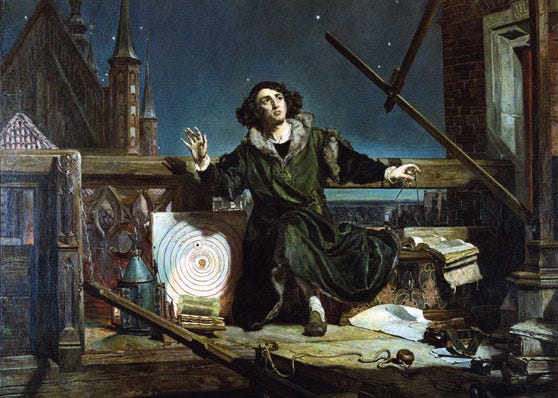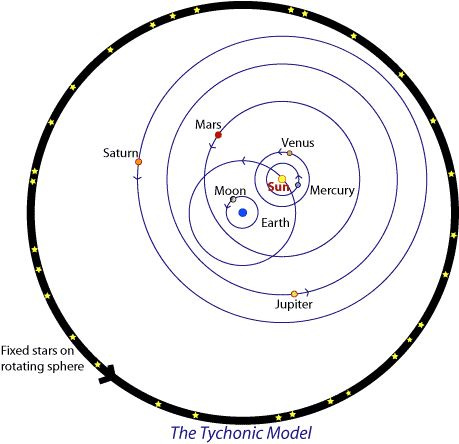Sunday, March 3, 2024
Heliocentricity and Theoretical Proofs (part two). Forces which Copernicanism cannot explain.
Neither can the Sun-worshippers explain why the Earth does not fall into the Sun.
by StFerdIII

(The gallant Copernicus leading mankind to insignificance and irrelevance)
“Most scientists refused to accept [Copernicus’s] theory for many decades — even after Galileo made his epochal observations with his telescope. Their objections were not only theological. Observational evidence supported a competing cosmology,the “geo-heliocentrism” of Tycho Brahe. The most devastating argument against the Copernican universe was the star size problem. Rather than give up their theory in the face of seemingly incontrovertible physical evidence, Copernicans were forced to appeal to divine omnipotence.”
(The Case Against Copernicus by Dennis Danielson and Christopher M. Graney)
The ‘star size problem’ was an early objection to Copernicanism, given that the stars must be far away, yet they are visible and defined. This implies a massive size, hundreds if not thousands of times bigger than our Sun for example. Yet their appearance in the sky is small and uniform. The only way to explain this is by invoking a divine presence, or appealing to the distortion of light and optical illusions.
Optical explanations were not forthcoming until the mid 18th century though even now there is dispute about the validity of these claims. Stars are still seen as ‘points of light’, and very few adequate explanations exist which satisfy the ‘star size’ issue, though it is generally ignored in modern science, which views the ‘optical illusion’ explanation as sufficient.
Putting this issue to the side, we can list the standard textbook ‘proofs’ for heliocentricity which will be discussed and analysed in sequence:
1. Newton’s theory of gravitational attraction (this is false, see the previous post and this post below)
2. The Stellar Parallax (#2-11 covered in future posts)
3. Stellar aberration of the Sun
4. The Foucault Pendulum
5. The bulge at the Equator
6. Geosynchronous satellites
7. Space probe measurements
8. Retrograde motion (this post)
9. Star-streaming
10. The Doppler effect
11. Geometric complexity of geocentrism
Prologue
Previous posts have looked at the paucity of real evidence for heliocentricity. Remarkably these failures in experimentation or evidence, are always turned into ‘proofs’ by ‘The Science’. Other models can explain the same phenomena but are dismissed out of hand due to the philosophical-world or universe-view that heliocentricity ‘must be right’. The reality is that there is not a single mechanical proof to support this theory (posts outlining this are shown at the end). This deposition follows from the problems with Newton’s law of gravitation which cannot explain how planets and constellations behave and why it does not support heliocentricity.
Models and problems
‘The Science’ and its heliocentric model explain that within our solar system the planets revolve around the Sun, and our milky way galaxy revolves around a center of the Universe whose location has never been identified. In this theory, which is a part of the discredited Big Bang dogma, gravitational attraction between smaller and larger bodies ‘holds’ the patterns of orbits and the relationships between planets. There are many issues with this theory. A simple one is the following question.
Problem Statement: Given that approximately 1 million Earths fit into the Sun, why doesn’t the Sun simply consume our Earth?
Related to this we can ask, why doesn’t the Earth consume the moon given that the Earth’s diameter is 4 times that of the moon? The answer is that there are issues with the ‘laws’ of gravity, given they don’t explain the observed phenomena nor answer the simple question above. Gravity is a weak force, so some other ‘forces’ must be at work.
A second model which offers an answer to the above question is the Tychonic-Ptolemaic concept, where the Earth is immobile at the center of the universe and the planets in our solar system either revolve around the Earth (Ptolemy), or the planets revolve around the Sun and this collection revolves around the Earth (Tychonic). Tycho Brahe’s model is thus a mixture of heliocentricity and geocentricity, based on thousands of observations and calculations. Mathematically, even using modern scientific standards and observations, both the Ptolemaic and Tychonic models are valid, though no one is told this.
Video, summary overview of the Heliocentric, Tychonic and Ptolemaic models
In the Tychonic model the entire universe revolves around the Earth. The Earth may still rotate (the neo Tychonic or semi-Tychonic model) or be immobile as Tycho Brahe believed. The massive force used to generate the phenomenal speeds to rotate the universe around the Earth is a logical objection to this model of planetary movement. These objections, as outlined below, can however be answered using the standards and principles of modern science (Assis, pp. 190-191).
I am not suggesting that the model is right or wrong, but as will be shown, mathematically using modern science’s own postulates there is no argument against this model. The model also explains phenomena that Newtonian and standard Copernicanism cannot. I am only looking at Socratic proofs to resolve the problem statement:
‘Why doesn’t the Sun consume the Earth?’
The point is that the observational evidence, the universal forces which are confirmed by modern science including the Coriolis force, the Euler force and centrifugal forces (which are discussed below), the existing mathematics and models, and the affirmed principles and ‘laws’ of modern science, do not disprove the Tychonic system, but actually confirm much of what it postulates. The Tychonic model addresses the problem statement posted above, whilst heliocentricity does not provide an answer, hence the use of Dark Matter (a made up never-found constant to balance equations akin to Einstein’s steady-state model constant) and extended maths to Newton’s and Einstein’s equations.
Mach-o, Mach-o man
In the neo-Tychonic model, the gravitational attraction of the Sun with the Earth is balanced by a real gravitational-centrifugal force generated by the annual rotation of distant masses around the Earth (with a component having a period of one year). In this model the Earth can remain at rest, a constant distance from the Sun. Modern science can have no objection to this idea of geo-helio-centrism due to the duality of its own force laws and the theory of Relativity.
Using Mach’s Principle and Einstein’s General Theory of Relativity which employs the same; we can see that the neo-Tychonic model where the Earth is at rest in the center of the universe and has the Sun revolving around it, is not madness. Universal distant matter (e.g., galaxies) which rotate around the Earth could create a centrifugal force, which is like gravity, but actually counteracts the force of gravity, keeping the Sun a certain distance from the motionless Earth, namely, 91-94 million miles. These forces would be the ‘Coriolis force’ (more below). This could help explain why the Earth does not fall into the Sun, or why our moon does not missile bomb the Earth (Popov, 383-391).
As Einstein admits:
“We need not necessarily trace the existence of these centrifugal forces back to an absolute movement of K' [Earth]; we can instead just as well trace them back to the rotational movement of the distant ponderable masses [stars] in relation to K' whereby we treat K' as ‘at rest.’…On the other hand, the following important argument speaks for the relativistic perspective. The centrifugal force that works on a body under given conditions is determined by precisely the same natural constants as the action of a gravitational field on the same body (i.e., its mass), in such a way that we have no means to differentiate a ‘centrifugal field’ from a gravitational field….
This quite substantiates the view that we may regard the rotating system K' as at rest and the centrifugal field as a gravitational field….The kinematic equivalence of two coordinate systems, namely, is not restricted to the case in which the two systems, K [the universe] and K' [the Earth] are in uniform relative translational motion.” (Einstein’s October 1914 pp. 69, 71).
Einstein has confirmed that a Tychonic or Ptolemaic universe is certainly feasible and possible. It is as least as credible as the Copernican faith which has the Earth moving through the ether (a medium largely denied by ‘The Science’) at 108.000 km per hour. Quite a clip. Many posts have discussed that no mechanical proofs for this have ever been presented (listed at the end). It is only 500 years since the days of Copernicus. Take your time. More here
